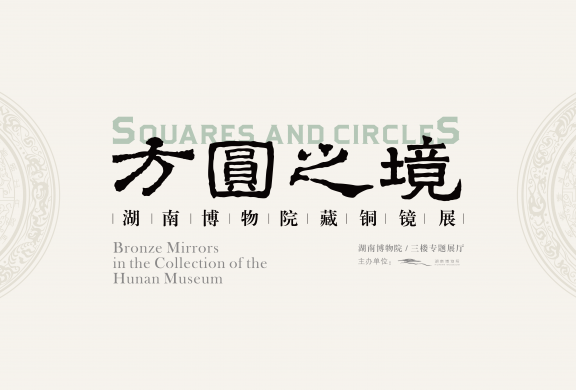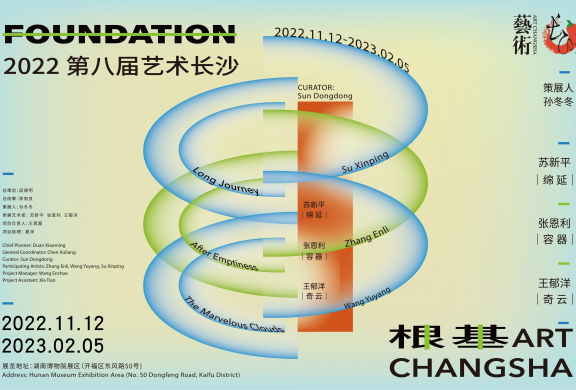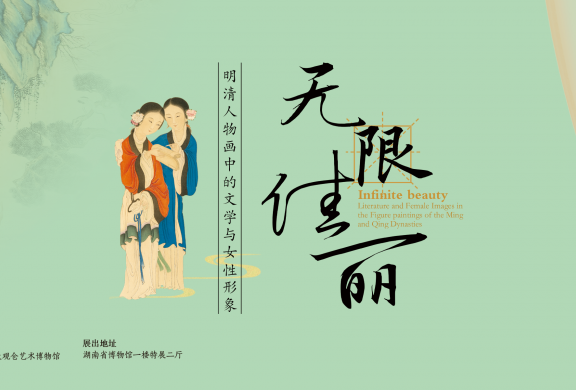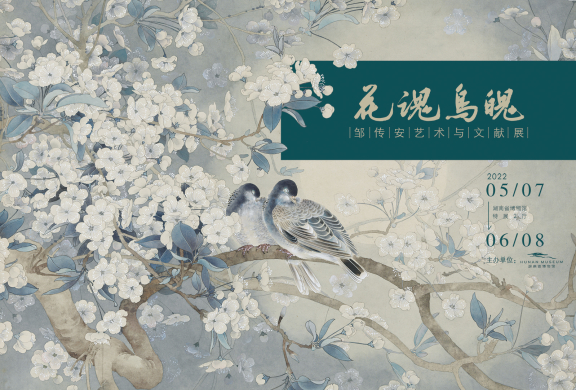Past Exhibitions
Exhibition of the Sanxitang Shiqubaoji Model Calligraphy ⅡThemed Exhibition Hall, 3F 2022.12.30 - 2023.10.08 |
Squares and Circles—Exhibition of Bronze MirrorsThemed Exhibition Hall, 3F 2022.12.08 - 2023.11.30 |
Foundation: the Art Changsha 2022No.1 and No.2 Special Exhibition Hall, 1st Floor 2022.11.03 - 2023.02.05 In the Chinese modern art history, there was a correction of appellation concerning the art medium: after the founding of the People’s Republic of China, the generally accepted appellation of "foreign painting" or "western painting" in the first half of 20th century was swiftly substituted by the name of "oil painting" which was named after its material feature. However, there was difference of only a single word, the appellation of oil painting interpreted the promotion, dissemination and practice of it, as well as corresponding transformation and construction of modern art in China, as the practicing process of learning advanced culture to nurturing new culture. From the perspective of "culture-politics", the appellation of oil painting suggested that China's modernization was an internalization process oriented to the "world picture". How to interpret the internalization process of China’s modernization, or rather, how to establish the historical consistency between China’s contemporary art and China’s modern art, is the focus and thinking topic of this exhibition. In fact, when facing the current Chinese society, there were numerous people in China’s contemporary ideological sphere advocated that the public should grasp and deal with the historical correlation among three traditions of Confucian culture, socialist revolution and the reform and opening up. Moreover, scholars coincidentally mentioned that it was necessary to confront the significance of the entire traditional Chinese historical culture to the historical foundation and spiritual foundation of modern China—as an inspiration for ideological plans, the transcendence of spacetime displayed by Chinese civilization has undoubtedly set up a larger historical and cultural framework for the topics covered in this exhibition, which is a reflection of Chinese contemporary art. "Foundation" of this exhibition consists of three solo art exhibitions of Chinese artists: Zhang Enli’s "After Emptiness",Wang Yuyang's "The Marvelous Clouds" and Su Xinping’s "Long Journey". As for the concept and practice of art, although three artists own different orientations, from their artworks, the public could capture a modern experience of Chinese art represented by oil painting throughout the ancient and modern times: one is universal living world that keeps pace with the times, and the other is the value world of thinking and presenting "who we are", the two worlds are dialectically unified in the narrative and practice of self-history. Therefore, in a sense, the "civilization" here does not mean a context of the past, on the contrary, it is a scene of historical possibility about how we move towards the future. |
Hearing and Seeing Huxiang - the Exhibition of Hunan Musical RelicsNo.1 Special Exhibition Hall 2022.07.28 - 2022.10.30
Foreword Music is the forerunner of civilization, nourishes the childhood of human beings, and carries the future of the nation. Hunan is located in the middle reaches of the Yangtze River, south of Dongting, and is one of the important cradles of Chinese civilization. The landscapes in Hunan are gorgeous, everything is vigorous, and rivers flows for ages, nurturing unique and rich musical culture. More than 6,000 years ago, the sounds of ancient musical instruments(stone whistles, pottery balls and pottery drums) flied on the Liyang Plain, accompanied by the joy of work; on the banks of the Weishui River, resounding with the sound of Nao of the Shang and Zhou Dynasties; on the banks of the Miluo River, the sorrow of Quyuan echoed; various types of musical performances acted in the Han and Jin Dynasties; exotic music prospered in the Sui, Tang, Song and Yuan Dynasties; ancient music of Liuyang opened a new chapter in ritual music culture. Music is the common language of all mankind, thousands of years have passed, can these silent notes in history be awakened again today? Listen,the sound of Huxiang—the most beautiful language, either whispered or chirped, soothing or abrupt, soft or strong, deep or distant, tells the longing and call of the ancestors of Huxiang for a better life. Let us start a wonderful audio-visual journey in this eternal and beautiful music world! Chapter One In the late Shang and the early Zhou Dynasties, local artisans in Hunan, a region influenced by the Shang culture of the Central Plains, created a large bronze musical instrument-Nao. The further development of bronze instruments such as Nao, Zhong, and Bo, and the determination of two-tone effect, laid the foundation for the ritual music culture of the Zhou Dynasty. Chapter Two From the mid-Spring and Autumn Period to the Warring States Period, Hunan was incorporated into the territory of Chu(State), and its music culture showed the solemn and profound, romantic and sentimental beauty of Chu tunes, including the ritual music needed to maintain the ritual system, as well as the folk music to release the mind, and the verses of Chu, which not only pleased people, but also entertained the gods. The diversity of musical instruments has also foster the "Eight-Tone Harmony" musical performance form, which constituted the grandeur of Chu’s music and dance. Chapter Three Since the Qin and Han Dynasties, Hunan has become an important part of China's unified multi-ethnic country, and many material relics of musical culture have been left throughout the ages. During the period of the Han, Wei and Jin Dynasties, the traditional Chinese music form changed from the ritual music to the dance music, and a large number of excavated objects and portrait bricks and stone reliefs of Han Dynasty showed various types of musical performances that combined instrumental music, singing and dancing, acrobatic and other art forms at that time, reflecting time features of people’s pursuit of high-quality and joyful life. Chapter Four The Tang Dynasty saw unprecedented prosperity in culture and art, with unprecedented development in dance music, especially court ·music, and the exotic style was also spread to the land of Hunan. From the late Tang Dynasty to the Song Dynasty, the music of the literati became unique, and the entertainment culture of the citizens also flourished, especially during the Yuan and Song Dynasties, the dramas were popular throughout the country. The musical relics unearthed in Hunan reflected the flourishing musical art achievements of this period under the heyday of national unification. Chapter Five Since the Ming and Qing Dynasties, Huxiang music has entered a new stage of historical development, people of civil and military ability could express their political aspirations through music, conveying their sentiments of governing the world and saving the country, as well as their desire to survive and innovate. In addition, there is music of the ethnic groups, which is cheerful and joyful, commemorates the spirits of the ancestors, and encourages production.The "Ding Festival" at the Wenmiao Temple in Liuyang is a direct testimony to the traditional culture of respecting Confucianism, and highlights the magnificent music of Hunan. Last Chapter Gathering together, on the shore of Hunan, the ancient music is still in the ears, and the familiar melody comes out naturally. Ancient poetry and paintings are displayed, the music is melodious and acclaimed...
|
Infinite Beauty—Literature and Female Images in Figure Paintings of the Ming and Qing DynastiesNo.2 Special Exhibition Hall 2022.06.23 - 2022.10.30 Looking down, they come with an agreeable smile— Infinite beauty, beauties are infinite. In the inheritance and development of figure paintings in the Ming and Qing dynasties, many famous or unknown masters of traditional Chinese painting, from making classical allusions to viewing Chinese learning as substance, western learning for application, from pen and ink portrayal to a vivid touch, recorded lifelike female images and their soul-stirring literary stories in history. Today, they meet us after shaking off hundreds of years of established rules of secular society... Perhaps, inside and outside the frames, brand-new life and significance is made possible for them when we look at the women face to face. |
Exhibition of Zou Chuan'an Art and Literature— "The Soul of Flower and Bird"No.2 Special Exhibition Hall 2022.05.07 - 2022.06.08 Chinese meticulous flower-and-bird painting originated from the Wei and Jin Dynasties, matured in the Tang Dynasty, and thrived in the Five Dynasties and the Song Dynasty. Since the founding of the People's Republic of China, meticulous flower-and-bird painting with profound traditions has taken on a new look. The Hunan style presented in the Hunan meticulous flower-and-bird painting is unique in the country, showing the artistic spirit of fine research and pioneering. Zou Chuan'an is an important painter in the field of meticulous flower-and-bird painting in Hunan and even in the whole country. He has created his own unique style of "Zou's Flower and Bird". His style of painting has guided a group of domestic meticulous painters and laid the foundation for the contemporary transformation of Chinese meticulous painting. Fan Di'an, president of the China Artists Association, once commented that Zou Chuan'an’s art has reached a new height in three aspects: First, he takes the shape of the image, instead of relying on the painting manual and ancient books; Second, the vision of setting is extremely broad; Third, exquisite skills can be seen in the vivid portrayal. Lin Fan, the former president of the China Hue Art Association, spoke highly of Zou Chuan'an at the academic seminar, "This is the pride of Hunan and the pride of the Chinese meticulous painting". With the help of generous life feelings and immersed artistic courage, Zou Chuan'an integrates exquisite skills, unique aesthetics and life perception into flowers and birds and turns them into "the Soul of flowers and birds". In 2013 and 2021, Zou Chuan'an donated more than 1,000 pieces of his representative works, paintings and manuscripts of various periods to the Hunan Museum. These works formed a systematic collection of Zou Chuan'an, and enriched and extended the "Hunan famous calligraphy and painting collection" series in the Hunan Museum. After systematic sorting and research, the Hunan Museum launched the "The Soul of Flower and Bird—Zou Chuan'an Art and Literature Exhibition", which comprehensively displayed the artistic experience, artistic characteristics and achievements of Zou Chuan'an over the past 60 years, with a total of more than 300 pieces (sets) of calligraphy and painting works and literature materials exhibited. The Hunan Museum also hopes that it can promote the research of local artists and the artists in Hunan through this exhibition, continue the art history of Hunan, and provide a useful reference for the inheritance and development of meticulous flower and bird paintings since the 20th century. |








